-
Paper Information
- Next Paper
- Previous Paper
- Paper Submission
-
Journal Information
- About This Journal
- Editorial Board
- Current Issue
- Archive
- Author Guidelines
- Contact Us
American Journal of Materials Science
p-ISSN: 2162-9382 e-ISSN: 2162-8424
2011; 1(1): 52-56
doi: 10.5923/j.materials.20110101.08
Frequency Dependence of the Electrical Conductivity and Dielectric Constants of Polycarbonate (Makrofol-E) Film under the Effects of γ-Radiation
S. Fares
National Center for Radiation Research and Technology (NCRRT), AEA, P.O. 29 Nasr City Egypt
Correspondence to: S. Fares , National Center for Radiation Research and Technology (NCRRT), AEA, P.O. 29 Nasr City Egypt.
| Email: |  |
Copyright © 2012 Scientific & Academic Publishing. All Rights Reserved.
Irradiation effects of γ-radiation on the physical and electrical properties of polycarbonate (Makrofol-E( film has been studied to be able to investigate the dielectric response of irradiated polymers for a wide range of fluence and frequency. The dielectric constant (έ)The loss tangent ( tanδ ), dielectric loss factor (ε˝), the a.c electrical conductivity (σ) and the relaxation time (τ), were measured in the frequency range from (40) Hz to (4)MHz. These samples were irradiated by means of γ-rays from 10 up to 200 KGy. The change in different properties as a function of absorbed dose was studied. Degradation of the polymers leading to amorphisation was observed by increasing the absorbed γ-dose. The induced changes in the electrical conductivity due to γ -rays irradiation of Makrofol-E provide a better method for γ -dose measurements. A semi-empirical equation was developed to use Makrofol-E as a dielectric dosimeter. Furthermore, Makrofol-E has much greater resistance to radiation damage; the attained results suggested strongly the applicability of Makrofol-E to be used in medical products applications.
Keywords: Gamma-ray, Dose-response, PC Polycarbonate, Makrofol-E Chain Scission, Cross Linking, a.c Electrical Conductivity, Dielectric Constant and Dielectric Loss
Cite this paper: S. Fares , "Frequency Dependence of the Electrical Conductivity and Dielectric Constants of Polycarbonate (Makrofol-E) Film under the Effects of γ-Radiation", American Journal of Materials Science, Vol. 1 No. 1, 2011, pp. 52-56. doi: 10.5923/j.materials.20110101.08.
Article Outline
1. Introduction
- Polymeric materials are unique because of the range of structural forms that can synthesized and the way in which changes can be made in the structure in local or general way. Polymer composites have steadily gained growing importance during the past decade. Appreciable gain in the knowledge of the structure of such materials has been accomplished through electrical conductivity measurements. Also external parameters, such as the effect of γ-radiation, play a role in the electrical behavior of such polymer[1]. The irradiation of polymeric materials with ionizing radiation (gamma rays, X rays, accelerated electrons, ion beams) leads to the formation of very reactive intermediates products (excited states, ions and free radicals), which result in rearrangements and/or formation of new bonds. The effects of these reactions are formation of oxidized products, grafts, scission of main chain (degradation) or cross-linking. Often the two processes (degradation-cross-linking) occur simultaneously, and the outcome of the process is determined by a competition between the reactions[2,3]. Oxidation and degradation occur gradually with increasing irradiation dose. Different polymers have different responses to radiation, which are intrinsically related to the chemical structures of the polymers. Polymers with more hydrogen atoms on side (e.g., polyethylene) tend to cross-link with radiation. Polymers with a methyl group (e.g., polypropylene), di–substitutions (e.g., polymethacrylate) and per-halogen substitutions (e.g., polytetrafluoroethlene) would more likely undergo degradation with radiation. Aromatic polymers with benzene rings either in the main chain or on the side (e.g., polycarbonate) are usually radiation resistant[4]. Polycarbonate (PC) is a well-known engineering thermoplastic with an excellent balance of optical, physical, mechanical, and processing characteristics[5]. Polycarbonate detectors are used as a particle track detector for neutrons and alpha particles detection[6,7]. Moreover, radiation effects on dielectric properties are of particular interest to science and technology and they have many applications in modern engineering[8-11], and the effect of ion irradiation on the dielectric properties of polymers has been also studied earlier[12-15].It is well known that irradiation enhance the electrical conductivity in insulating polymers. This increase in conductivity is attributing to the amplifications of conjugated structure, i.e fairly great electron freedom. The irregularity in the polymer chains may also give rise to a hopping mechanism which will enhance the conductivity. Among many dielectric of capacitors P. P, PFT films has greatly reduced the volume of the capacitors because of its large electric strength together with its low dissipation factor (tanδ)[16].The improvement of the dielectric properties has been investigated by high electron irradiation of these polymers[17]. The influence of radiation on the properties and performance of a polymer differs according to whether the material degrades or cross-links and this is in turn depends on specific sensitivities or susceptibilities inherent in the polymer backbone. All materials have been found to break down at very high radiation doses, however, the range of doses under which a given polymer will maintain its desirable properties depends greatly on the chemical structure of the polymers. Indeed, below the destructive level of exposure, radiation treatment can impart many benefits and enhance properties of commercial value[18-21]. Therefore in the present work I investigated experimentally the radiation induced conductivity (RIC) for Makrofol-E film - and by gaining sufficient knowledge about these beneficial radiation, induced effect, - which are suitable for use as sensitive γ-dosimeter. A theoretical model is suggested to estimating the RIC in insulating materials.
2. Experimental Procedure
- Makrofol-E is a bisphenol-A polycarbonate of chemical composition (C16H14O3), with an average thickness of 0.275 mm and the surface area of the sample is (0.612 Cm2). Makrofol-E polycarbonate samples were irradiated with different γ - doses at room temperature in air with 60Co - gamma cell. The applied radiation dose on the Makrofol-E sample was (10-200) KGy. Makrofol polycarbonate samples were cut into square pieces and coated with silver paste to achieve ohmic contacts. The measurements of dielectric constant (έ), dielectric loss factor (ε˝) and loss tangent tan (δ) before and after being irradiated were measured using 3531 ZHITESTER (RLC) digi bridge manufactured by HIOKI, E.E. Corporation, having a frequency range of (40 Hz) up to (4MHz) in the room temperature. The dielectric parameters (έ) and (ε˝) and the electrical conductivity (σ) were evaluate using the conventional formula discussed[22,23].These formulas are:
 | (1) |
 | (2) |
 | (3) |
 | (4) |
 | (5) |
 | (6) |
 | (7) |
3. Results and Discussion
- The various assumption made in our discussion can be better appreciated by studying the variations of (έ) with frequency for different γ-doses. These variations for Makrofol-E samples are depicted in Figure. 1. Dielectric constants (έ) measurement were performed over frequency rang from (40 Hz) to (4MHz). Figure.1. shows three responses frequency bands for Makrofol-E samples. At all doses, the samples show that in the (0.2 – 1.2MHz) frequency range, the (έ) slightly decreases as the frequency increases. In the second band (1.2 – 1.7MHz), it seems to be (έ) sharply increase which is due to the main relaxation process. The third frequency band (1.7 – 4MHz) shows that (έ) sharply decrease with the frequency, which is attributed due to the dielectric dispersion. As evident from the graph, the dielectric constants remain almost constant up to 1.2MHz and then decreases at higher frequencies. At lower frequencies the motion of the free charge carriers is constant and thus the dielectric constant is constant. As the frequency increases, the charge carriers migrate through the dielectric and get trapped against a defect site and induce an opposite charge in its vicinity, as a result of which motion of charge carriers is slowed down and the value of dielectric constant decreases.
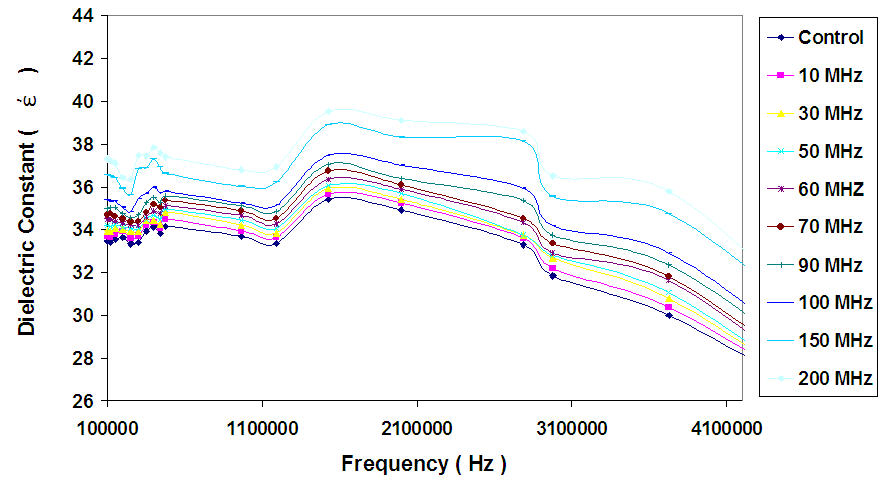 | Figure 1. Frequency dependence of the dielectric constant of Makrofol – E samples at different radiation doses. |
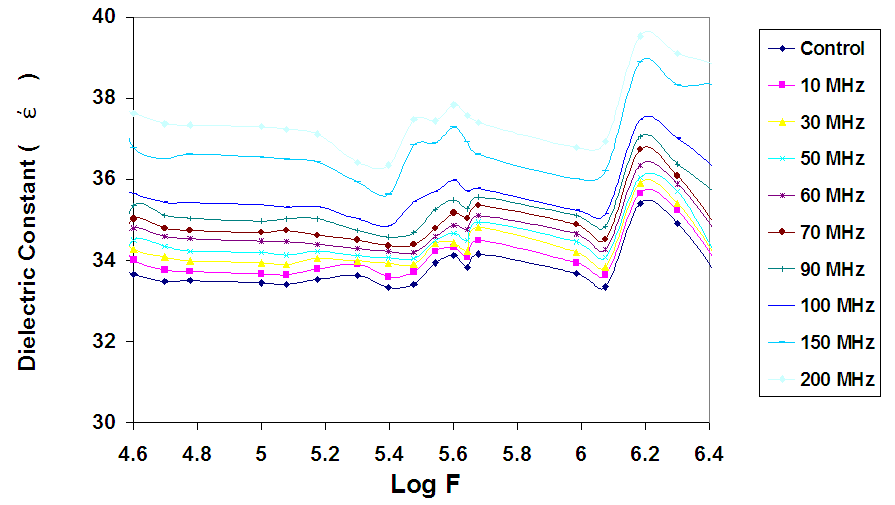 | Figure 2. Dielectric constant as a function of Log (Frequency) for different gamma doses Makrofol – E samples. |
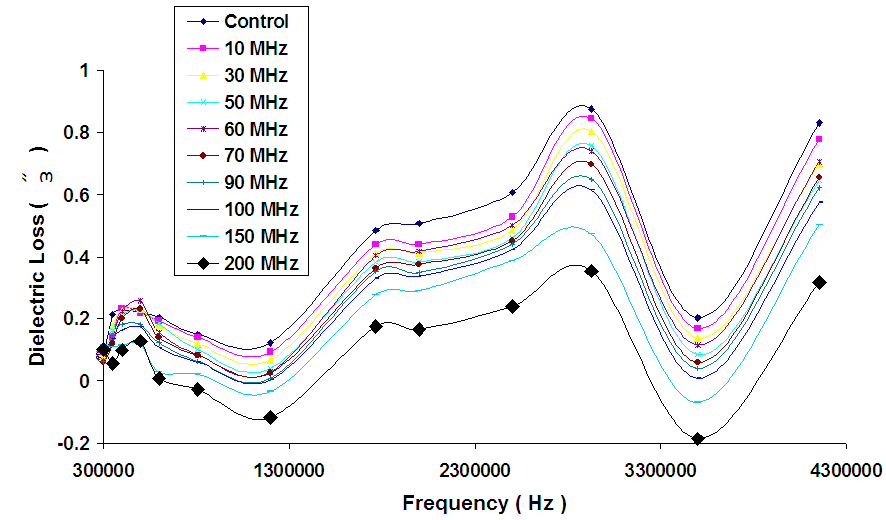 | Figure 3. Frequency dependence of the dielectric loss of Makrofol – E samples at different radiation doses. |
|
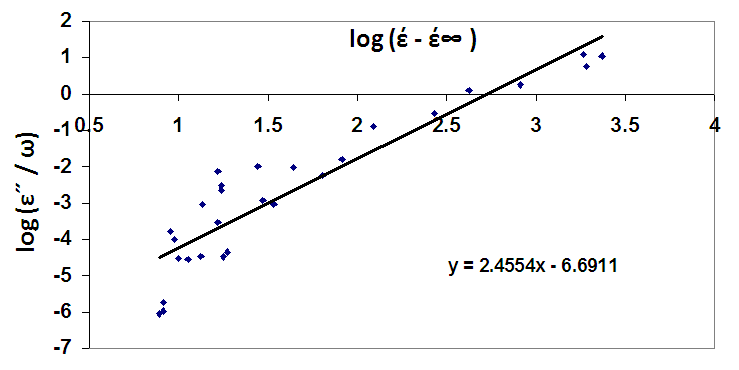 | Figure 4. Dielectric relaxation time for the Makrofol – E control sample. |
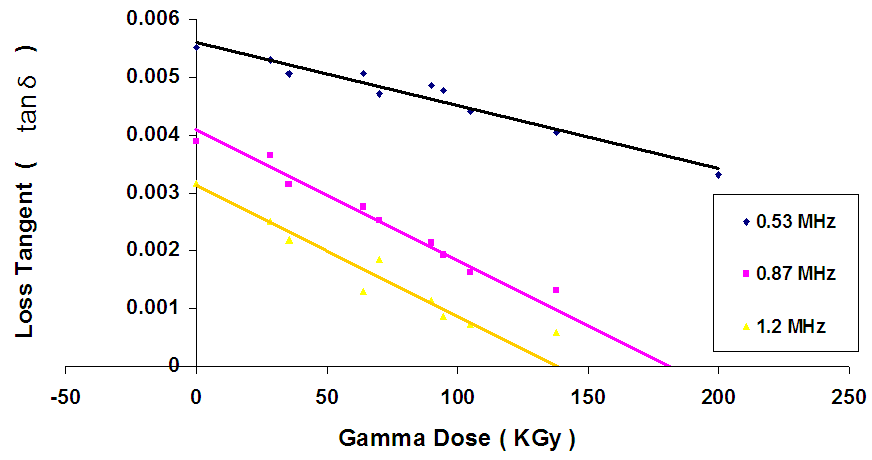 | Figure 5. Loss tangent versus gamma dose for Makrofol – E samples at different frequency. |
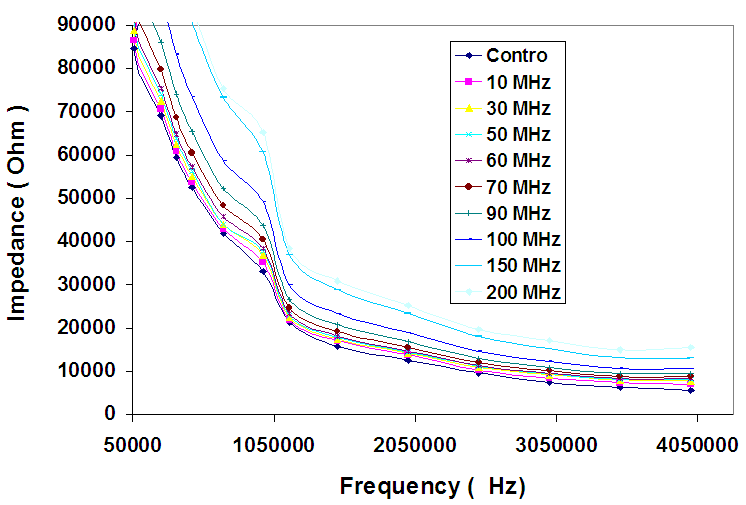 | Figure 6. Impedance versus frequency for Makrofol – E samples at different radiation doses. |
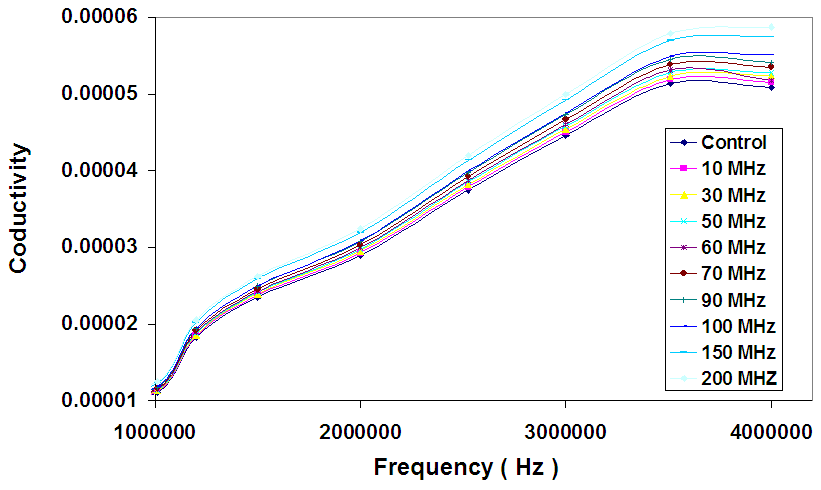 | Figure 7. The a c Conductivity of the Makrofol – E samples versus frequency at different radiation doses. |
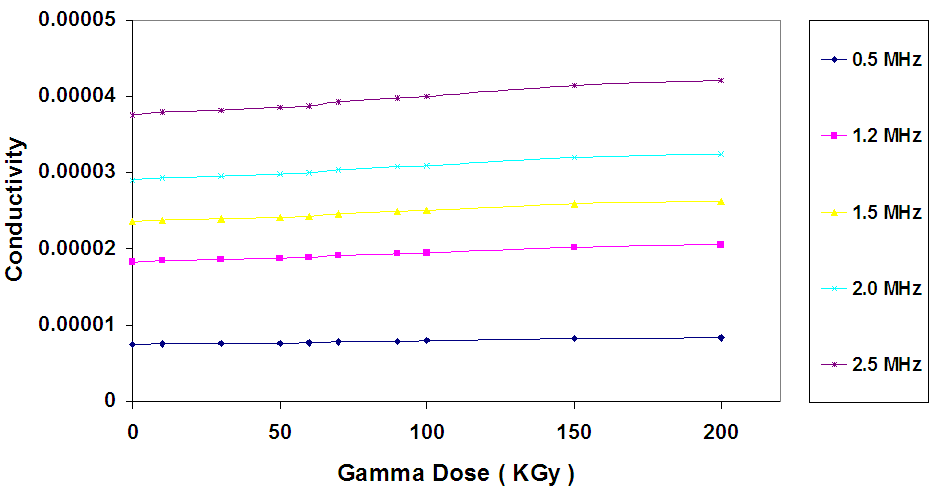 | Figure 8. The a.c Conductivity of the Makrofol – E samples versus radiation doses at various frequency values. |
4. Conclusions
- Makrofol-E polycarbonate films were irradiated with γ-radiation to study the modification in dielectric properties induced by irradiation..Ionizing radiation interacts with polymers via two primary mechanisms, chain scission to reduce molecular weight and cross-linking to generate large polymer networks. Both mechanisms occur and its effects vary from polymer to polymers and to some degree from part to part, during irradiation, but one generally dominates. Our experimental results of electrical properties of the Makrofol-E samples prove that, the samples vary in sensitivity to radiation. That is mean, Makrofol-E polymer have much greater resistance to radiation damage, so we suggest Makrofol-E to be used in medical products applications. It has been observed that under γ- irradiation, dielectric constant decreases with frequency whereas dielectric loss shows random behavior. It increases up to 2.8MHz followed by a decrease up to 3.5 MHz.
ACKNOWLEDGMENTS
- The auther sincerely thanks Dr. S.M.Abdou, Assi.Prof. and prof.Dr.A.korna, for research faciliteis and helpful discussions which enabled this work to be carried out. This work supported by the Departement of Radiation Physics, National Center for Radiation Research and Technology (NCRRT), Cairo, Egypt, is also gratefully acknowledged.
 Abstract
Abstract Reference
Reference Full-Text PDF
Full-Text PDF Full-Text HTML
Full-Text HTML